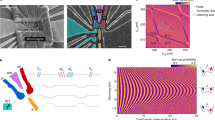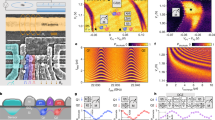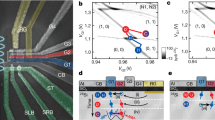Abstract
Fault-tolerant quantum computers that can solve hard problems rely on quantum error correction1. One of the most promising error correction codes is the surface code2, which requires universal gate fidelities exceeding an error correction threshold of 99 per cent3. Among the many qubit platforms, only superconducting circuits4, trapped ions5 and nitrogen-vacancy centres in diamond6 have delivered this requirement. Electron spin qubits in silicon7,8,9,10,11,12,13,14,15 are particularly promising for a large-scale quantum computer owing to their nanofabrication capability, but the two-qubit gate fidelity has been limited to 98 per cent owing to the slow operation16. Here we demonstrate a two-qubit gate fidelity of 99.5 per cent, along with single-qubit gate fidelities of 99.8 per cent, in silicon spin qubits by fast electrical control using a micromagnet-induced gradient field and a tunable two-qubit coupling. We identify the qubit rotation speed and coupling strength where we robustly achieve high-fidelity gates. We realize Deutsch–Jozsa and Grover search algorithms with high success rates using our universal gate set. Our results demonstrate universal gate fidelity beyond the fault-tolerance threshold and may enable scalable silicon quantum computers.
This is a preview of subscription content, access via your institution
Access options
Access Nature and 54 other Nature Portfolio journals
Get Nature+, our best-value online-access subscription
$29.99 / 30 days
cancel any time
Subscribe to this journal
Receive 51 print issues and online access
$199.00 per year
only $3.90 per issue
Buy this article
- Purchase on Springer Link
- Instant access to full article PDF
Prices may be subject to local taxes which are calculated during checkout




Similar content being viewed by others
Data availability
All data in this study are available from the Zenodo repository at https://doi.org/10.5281/zenodo.5508362.
References
Nielsen, M. A. & Chuang, I. L. Quantum Computation and Quantum Information (Cambridge Univ. Press, 2000).
Fowler, A. G., Mariantoni, M., Martinis, J. M. & Cleland, A. N. Surface codes: towards practical large-scale quantum computation. Phys. Rev. A 86, 032324 (2012).
Wang, D. S., Fowler, A. G. & Hollenberg, L. C. L. Surface code quantum computing with error rates over 1%. Phys. Rev. A 83, 020302(R) (2011).
Barends, R. et al. Superconducting quantum circuits at the surface code threshold for fault tolerance. Nature 508, 500–503 (2014).
Ballance, C. J., Harty, T. P., Linke, N. M., Sepiol, M. A. & Lucas, D. M. High-fidelity quantum logic gates using trapped-ion hyperfine qubits. Phys. Rev. Lett. 117, 060504 (2016).
Rong, X. et al. Experimental fault-tolerant universal quantum gates with solid-state spins under ambient conditions. Nat. Commun. 6, 8748 (2015).
Veldhorst, M. et al. An addressable quantum dot qubit with fault-tolerant control-fidelity. Nat. Nanotechnol. 9, 981–985 (2014).
Yoneda, J. et al. A quantum-dot spin qubit with coherence limited by charge noise and fidelity higher than 99.9%. Nat. Nanotechnol. 13, 102–106 (2018).
Veldhorst, M. et al. A two-qubit logic gate in silicon. Nature 526, 410–414 (2015).
Petit, L. et al. Universal quantum logic in hot silicon qubits. Nature 580, 355–359 (2020).
Yang, C. H. et al. Operation of a silicon quantum processor unit cell above one kelvin. Nature 580, 350–354 (2020).
Li, R. et al. A crossbar network for silicon quantum dot qubits. Sci. Adv. 4, eaar3960 (2018).
Vandersypen, L. M. K. et al. Interfacing spin qubits in quantum dots and donors—hot, dense and coherent. npj Quantum Inf. 3, 34 (2017).
Jones, C. et al. Logical qubit in a linear array of semiconductor quantum dots. Phys. Rev. X 8, 21058 (2018).
Zajac, D. M., Hazard, T. M., Mi, X., Nielsen, E. & Petta, J. R. Scalable gate architecture for a one-dimensional array of semiconductor spin qubits. Phys. Rev. Appl. 6, 054013 (2016).
Huang, W. et al. Fidelity benchmarks for two-qubit gates in silicon. Nature 569, 532–536 (2019).
Yang, C. H. et al. Silicon qubit fidelities approaching incoherent noise limits via pulse engineering. Nat. Electron. 2, 151–158 (2019).
Zajac, D. M. et al. Resonantly driven CNOT gate for electron spins. Science 359, 439–442 (2018).
Watson, T. F. et al. A programmable two-qubit quantum processor in silicon. Nature 555, 633–637 (2018).
Xue, X. et al. Benchmarking gate fidelities in Si/SiGe two-qubit device. Phys. Rev. X 9, 021011 (2019).
Loss, D. & DiVincenzo, D. P. Quantum computation with quantum dots. Phys. Rev. A 57, 120 (1998).
Petta, J. R. et al. Coherent manipulation of coupled electron spins in semiconductor quantum dots. Science 309, 2180–2184 (2005).
Reed, M. D. et al. Reduced sensitivity to charge noise in semiconductor spin qubits via symmetric operation. Phys. Rev. Lett. 116, 110402 (2016).
Takeda, K., Noiri, A., Yoneda, J., Nakajima, T. & Tarucha, S. Resonantly driven singlet–triplet spin qubit in silicon. Phys. Rev. Lett. 124, 117701 (2020).
Sigillito, A. J., Gullans, M. J., Edge, L. F., Borselli, M. & Petta, J. R. Coherent transfer of quantum information in silicon using resonant SWAP gates. npj Quantum Inf. 5, 110 (2019).
Deutsch, D. & Jozsa, R. Rapid solution of problems by quantum computation. Proc. R. Soc. Lond. A 439, 553–558 (1992).
Grover, L. Quantum mehannics helps in searching for a needle in a haystack. Phys. Rev. Lett. 79, 325–328 (1997).
Yoneda, J. et al. Robust micro-magnet design for fast electrical manipulations of single spins in quantum dots. Appl. Phys. Express 8, 084401 (2015).
Elzerman, J. M. et al. Single-shot read-out of an individual electron spin in a quantum dot. Nature 430, 431–435 (2004).
Morello, A. et al. Single-shot readout of an electron spin in silicon. Nature 467, 687–691 (2010).
Russ, M. et al. High-fidelity quantum gates in Si/SiGe double quantum dots. Phys. Rev. B 97, 085421 (2018).
Nakajima, T. et al. Coherence of a driven electron spin qubit actively decoupled from quasi-static noise. Phys. Rev. X 10, 11060 (2020).
Takeda, K. et al. A fault-tolerant addressable spin qubit in a natural silicon quantum dot. Sci. Adv. 2, e1600694 (2016).
Knill, E. et al. Randomized benchmarking of quantum gates. Phys. Rev. A 77, 012307 (2008).
Magesan, E. et al. Efficient measurement of quantum gate error by interleaved randomized benchmarking. Phys. Rev. Lett. 109, 080505 (2012).
Xue, X. et al. CMOS-based cryogenic control of silicon quantum circuits. Nature 593, 205–210 (2021).
Xue, X. et al. Computing with spin qubits at the surface code error threshold. Preprint at https://arxiv.org/abs/2107.00628 (2021).
Mądzik, M. T. et al. Precision tomography of a three-qubit electron-nuclear quantum processor in silicon. Preprint at https://arxiv.org/abs/2106.03082 (2021).
Noiri, A. et al. Radio-frequency-detected fast charge sensing in undoped silicon quantum dots. Nano Lett. 20, 947–952 (2020).
Connors, E. J., Nelson, J. & Nichol, J. M. Rapid high-fidelity spin state readout in Si/SiGe quantum dots via radio-frequency reflectometry. Phys. Rev. Appl. 13, 024019 (2020).
Takeda, K. et al. Quantum tomography of an entangled three-qubit state in silicon. Nat. Nanotechnol. 16, 965–969 (2021).
Muhonen, J. T. et al. Quantifying the quantum gate fidelity of single-atom spin qubits in silicon by randomized benchmarking. J. Phys. Condens. Matter 27, 154205 (2015).
Shulman, M. D. et al. Suppressing qubit dephasing using real-time Hamiltonian estimation. Nat. Commun. 5, 5156 (2014).
Dewes, A. et al. Characterization of a two-transmon processor with individual single-shot qubit readout. Phys. Rev. Lett. 108, 057002 (2012).
Acknowledgements
We thank the Microwave Research Group in Caltech for technical support. This work was supported financially by Core Research for Evolutional Science and Technology (CREST), Japan Science and Technology Agency (JST) (JPMJCR15N2 and JPMJCR1675), MEXT Quantum Leap Flagship Program (MEXT Q-LEAP) grant numbers JPMXS0118069228, JST Moonshot R&D grant number JPMJMS2065, and JSPS KAKENHI grant numbers 16H02204, 17K14078, 18H01819, 19K14640 and 20H00237. T.N. acknowledges support from JST PRESTO grant number JPMJPR2017.
Author information
Authors and Affiliations
Contributions
A.N. and K.T. fabricated the device and performed the measurements. T.N. and T.K. contributed the data acquisition and discussed the results. A.S. and G.S. developed and supplied the 28silicon/silicon-germanium heterostructure. A.N. wrote the manuscript with inputs from all co-authors. S.T. supervised the project.
Corresponding authors
Ethics declarations
Competing interests
The authors declare no competing interests.
Peer review information
Nature thanks the anonymous reviewer(s) for their contribution to the peer review of this work. Peer review reports are available.
Additional information
Publisher’s note Springer Nature remains neutral with regard to jurisdictional claims in published maps and institutional affiliations.
Extended data figures and tables
Extended Data Fig. 1 Detuning dependence of EDSR spectra.
a, Stability diagram around the (1,1) charge state. b, Quantum circuit for producing c. The microwave frequency of the \({\rm{\pi }}\) CROT on Q1 is varied to measure EDSR spectra. c, Detuning dependence of EDSR spectra of Q1. The detuning axis and its origin are shown as the white arrow and square in a. Three black symbols show the conditions where the dephasing times \({T}_{2,1,\downarrow }^{\ast }\) shown in d–f are measured. d–f, Ramsey fringes of Q1 when Q2 is spin-down measured at the detuning\(\,=-0.009\) V (d), \(0\) V (e), and \(0.009\) V (f). The integration time is 87 s for all of the traces. The errors in \({T}_{2,1,\downarrow }^{\ast }\) represent the estimated standard errors for the best-fit values. We observe longer (shorter) \({T}_{2,1,\downarrow }^{\ast }\) when the slope of the EDSR frequency against the detuning is smaller (larger), indicating the detuning charge noise limits \({T}_{2,1,\downarrow }^{\ast }\) at the charge-symmetry point where a finite slope exists due to the micromagnet-induced gradient field. A similar tendency is also observed in all the \({T}_{2,{\rm{m}},\sigma }^{\ast }\).
Extended Data Fig. 2 Qubits characterizations.
a, b, Sequences to measure spin relaxation times for Q1 when Q2 is spin-down, \({T}_{1,1,\downarrow }\) (a) and -up, \({T}_{1,1,\uparrow }\) (b). c, Spin-up probability as a function of the wait time. All of the traces do not show a decaying property indicating that spin relaxation is negligible for both qubits. The purple (magenta) curve is obtained using the sequence shown in a (b). The roles of Q1 and Q2 are swapped to measure the data for Q2. Each trace is offset by \(0.45\) for clarity. All of the measurements are performed with \(J=18.85\) MHz and \({f}_{{\rm{R}}}=4.867\) MHz. d, e, Ramsey sequences to measure dephasing times for Q1, \({T}_{2,1,\downarrow }^{\ast }\) and \({T}_{2,1,\uparrow }^{\ast }\). f, Ramsey fringes of Q1 and Q2 fitted with Gaussian decaying oscillation functions. The integration time is 87 s for all of the traces. The errors represent the estimated standard errors for the best-fit values. Each trace is offset by \(0.6\) for clarity. g, h, Echo sequences to measure echo times for Q1, \({T}_{2,1,\downarrow }^{{\rm{echo}}}\) and \({T}_{2,1,\uparrow }^{{\rm{echo}}}\). The phase of the final \({\rm{\pi }}/2\) rotation is varied and the amplitude of the measured oscillation as a function of the phase is plotted in i. i, Echo amplitudes as a function of the evolution time. The exponent of the decay is \(1.5,\,1.2,\,1.8\), and \(1.6\) for \({T}_{2,1,\downarrow }^{{\rm{echo}}}\), \({T}_{2,1,\uparrow }^{{\rm{echo}}}\), \({T}_{2,2,\downarrow }^{{\rm{echo}}}\), and \({T}_{2,2,\uparrow }^{{\rm{echo}}}\). The errors represent the estimated standard errors for the best-fit values. Each trace is offset by \(0.2\) for clarity. j, k, Measurement of Rabi decay time for Q1, \({T}_{2,1,\downarrow }^{{\rm{Rabi}}}\), and \({T}_{2,1,\uparrow }^{{\rm{Rabi}}}\). We measure Rabi oscillations by varying microwave burst time \({t}_{{\rm{burst}}}\) from \(0.01\) μs to \(0.41\) μs with a separation of \(0.01\) μs. Rabi oscillations for longer \({t}_{{\rm{burst}}}\) (offset by \(20\), \(40\), and \(80\) μs) are also measured and the amplitudes of the oscillations are plotted in l. l, Rabi oscillation amplitude as a function of the microwave burst time with decaying fits. The decay follows \({R}_{m,\sigma }(t)=\exp \,(-t/{T}_{2,m,\sigma }^{{\rm{Rabi}}})W(t)\) where \(W(t)={(1+{t}^{2}/{({f}_{{\rm{R}}}{({T}_{2,m,\sigma }^{\ast })}^{2})}^{2})}^{-1/4}\) represents the effect of dephasing32. From the fit, we extract the Rabi decay during a \({\rm{\pi }}/2\) CROT as \({D}_{m,\sigma }={R}_{m,\sigma }(t=1/(4{f}_{{\rm{R}}}))\). The errors represent the estimated standard errors for the best-fit values. Each trace is offset by \(0.5\) for clarity.
Extended Data Fig. 3 Single-tone single-qubit gate performance.
a, b, Quantum circuits of single-tone single-qubit Clifford-based randomized benchmarking for Q1 when Q2 is spin-down (a) and -up (b). c, Single-tone single-qubit primitive gate fidelities \({F}_{{\rm{p}},m,\sigma }\) assessed by the Clifford-based randomized benchmarking. The purple (magenta) curve is obtained using the sequence shown in a (b). The roles of Q1 and Q2 are swapped to measure the data for Q2. \({f}_{{\rm{R}}}=4.867\) MHz and \(J=18.85\) MHz \(=\sqrt{15}{f}_{{\rm{R}}}\) are used. Each trace is offset by \(0.15\) for clarity. The uncertainty in the gate fidelities are obtained by a Monte Carlo method4. The obtained fidelities are consistent with those obtained in Fig. 2c as \({F}_{{\rm{p}},m}\approx {F}_{{\rm{p}},m,\downarrow }{F}_{{\rm{p}},m,\uparrow }\). d, Rabi frequency dependence of single-tone single-qubit primitive gate infidelities. Since the control qubit state is fixed in this measurement, the off-resonant rotation does not matter so that \({f}_{{\rm{R}}}\) can be varied under a fixed \(J\) of \(32.0\) MHz. Therefore, the impact of \({f}_{{\rm{R}}}\) on the single-qubit gate performance is assessed without involving the effect of \(J\). We find that the fidelities depend on \({f}_{{\rm{R}}}\) and the best values are obtained at \({f}_{{\rm{R}}}=2\)–\(5\) MHz. Around the best condition, the fidelities are uniformly high suggesting that the fidelity is mostly limited by pulse imperfections and calibration errors rather than dephasing and Rabi decay effects. The uncertainty in the gate fidelities are obtained by a Monte Carlo method4.
Extended Data Fig. 4 Two-qubit gate fidelity extraction.
a, Number of Clifford gates \(n\) dependence of the projection state probability \({{\rm{P}}}_{\uparrow \uparrow }\)4,16. The ideal final state is spin-up for both qubits. To extract gate fidelity, we need to measure the saturation value of \({{\rm{P}}}_{\uparrow \uparrow }\) with a large \(n\) (Methods). The uncertainty in the gate fidelity is obtained by a Monte Carlo method4. b, Gate fidelity extraction from the sequence fidelity \({F}_{{\rm{t}}}\). In addition to the data in a, we measure another data set where the final ideal state is spin-down for both qubits and then obtain \({F}_{{\rm{t}}}\) as shown in blue (Methods). The saturation value of \({F}_{{\rm{t}}}\) is almost zero (\({F}_{{\rm{t}}}(271)=-\,0.007\)) as expected. Gate fidelity extraction using only the data up to \(n=62\) is shown in red. The uncertainty in the gate fidelities are obtained by a Monte Carlo method4. The trace is offset by \(0.1\) for clarity. The obtained gate fidelities agree well with that obtained in the standard protocol in a. The uncertainty in the fidelity is larger in a due to the uncertainty of the saturation value of \({{\rm{P}}}_{\uparrow \uparrow }\). \({f}_{{\rm{R}}}=5.732\) MHz and \(J=22.2\) MHz are used.
Extended Data Fig. 5 Estimation of two-qubit primitive gate infidelity by resonance frequency noise.
a, Time dependence of \(\Delta J/2=(\Delta {f}_{1,\uparrow }-\Delta {f}_{1,\downarrow })/2\) (blue), \(\Delta {f}_{1}=(\Delta {f}_{1,\uparrow }+\Delta {f}_{1,\downarrow })/2\) (purple), and \(\Delta {f}_{2}=(\Delta {f}_{2,\uparrow }+\Delta {f}_{2,\downarrow })/2\) (orange) extracted from repeated Ramsey fringe measurements (Methods). \(J\) is fixed at \(18.85\) MHz. Each trace is offset by \(0.25\) MHz for clarity. Single-qubit frequency noises (\(\Delta {f}_{1}\) and \(\Delta {f}_{2}\)) are larger than that of the exchange noise \(\Delta J/2\). b, Simulation of a two-qubit primitive gate infidelity by the frequency noises obtained in a (Methods). c, Similar to b but the case with inserting an idle time for both qubits to remove the controlled-phase accumulation during the CROT when switching \(J\) on and off18,31.
Extended Data Fig. 6 Detuning dependence of the two-qubit gate performance.
a, Detuning dependence of \(J\). \(J\) at the charge-symmetry point (detuning \(=\,0\) mV) is \(18.85\) MHz. b, Detuning dependence of the two-qubit primitive gate fidelity \({F}_{{\rm{p}}}\) (indigo circles) and the Rabi decay during the \({\rm{\pi }}/2\) CROT (colored squares) obtained similarly to Fig. 1f. Around the charge-symmetry point, we reproducibly obtain \({F}_{{\rm{p}}}\) higher than \(99\)%. In large positive and negative detuning, \({F}_{{\rm{p}}}\) sharply drops mainly due to the fast Rabi decay. The uncertainty in the gate fidelity is obtained by a Monte Carlo method4. The errors in the Rabi decay represent the estimated standard errors for the best-fit values.
Extended Data Fig. 7 Measurement error calibration in state tomography.
Typical joint probabilities measured with preparing \(|\uparrow \uparrow \rangle \), \(\tilde{|\uparrow \downarrow }\rangle \), \(\tilde{|\downarrow \uparrow }\rangle \), and \(|\downarrow \downarrow \rangle \). At \(J\,=18.85\) MHz, \(\tilde{|\downarrow \uparrow }\rangle =0.9995|\downarrow \uparrow \rangle +0.0310|\uparrow \downarrow \rangle \).
Extended Data Fig. 8 Output state of Deutsch–Jozsa algorithm and Grover search algorithm.
a–c, Real part of the measured density matrix for the final output states for \({f}_{0}\) (a), \({f}_{1}\) (b), and \({f}_{3}\) (c) in the Deutsch–Jozsa algorithm (Fig. 4a). d–f, Real part of the measured density matrix for the final output states for \({f}_{10}\) (d), \({f}_{01}\) (e), and \({f}_{00}\) (f) in the Grover search algorithm (Fig. 4b). The absolute values of the matrix elements for the imaginary parts are less than \(0.055\) (a), \(0.056\) (b), \(0.040\) (c), \(0.111\) (d), \(0.072\) (e), and \(0.081\) (f). The uncertainty in the state fidelities \(F\) are obtained by a Monte Carlo method16,19,41.
Extended Data Fig. 9 Bell state tomography.
a, Quantum circuit for the Bell state tomography. After the first \({\rm{\pi }}/2\) rotation, \({\rm{Z}}\text{-}{{\rm{CNOT}}}_{2}\) and \(-{{\rm{Z}}}_{2}/2\) \(({{\rm{Z}}}_{2}/2)\) are applied for b (c), \({{\rm{CNOT}}}_{2}\) and \({{\rm{Z}}}_{2}/2\) \((-{{\rm{Z}}}_{2}/2)\) are applied for d (e). \({I},\,{X}/2,\,{Y}/2,\,\)and \({X}\) acting on both qubits at the end change the measurement axis to implement the state tomography (Methods). b–e, Real part of the measured density matrix for the prepared Bell states for \({\Phi }^{-}\) (b), \({\Phi }^{+}\) (c), \({\Psi }^{-}\) (d), and \({\Psi }^{+}\) (e), respectively. The absolute values of the matrix elements for the imaginary parts are less than \(0.038\) (b), \(0.093\) (c), \(0.100\) (d), \(0.113\) (e). The uncertainty in the state fidelities \(F\) are obtained by a Monte Carlo method16,19,41.
Supplementary information
Rights and permissions
About this article
Cite this article
Noiri, A., Takeda, K., Nakajima, T. et al. Fast universal quantum gate above the fault-tolerance threshold in silicon. Nature 601, 338–342 (2022). https://doi.org/10.1038/s41586-021-04182-y
Received:
Accepted:
Published:
Issue Date:
DOI: https://doi.org/10.1038/s41586-021-04182-y
Comments
By submitting a comment you agree to abide by our Terms and Community Guidelines. If you find something abusive or that does not comply with our terms or guidelines please flag it as inappropriate.



